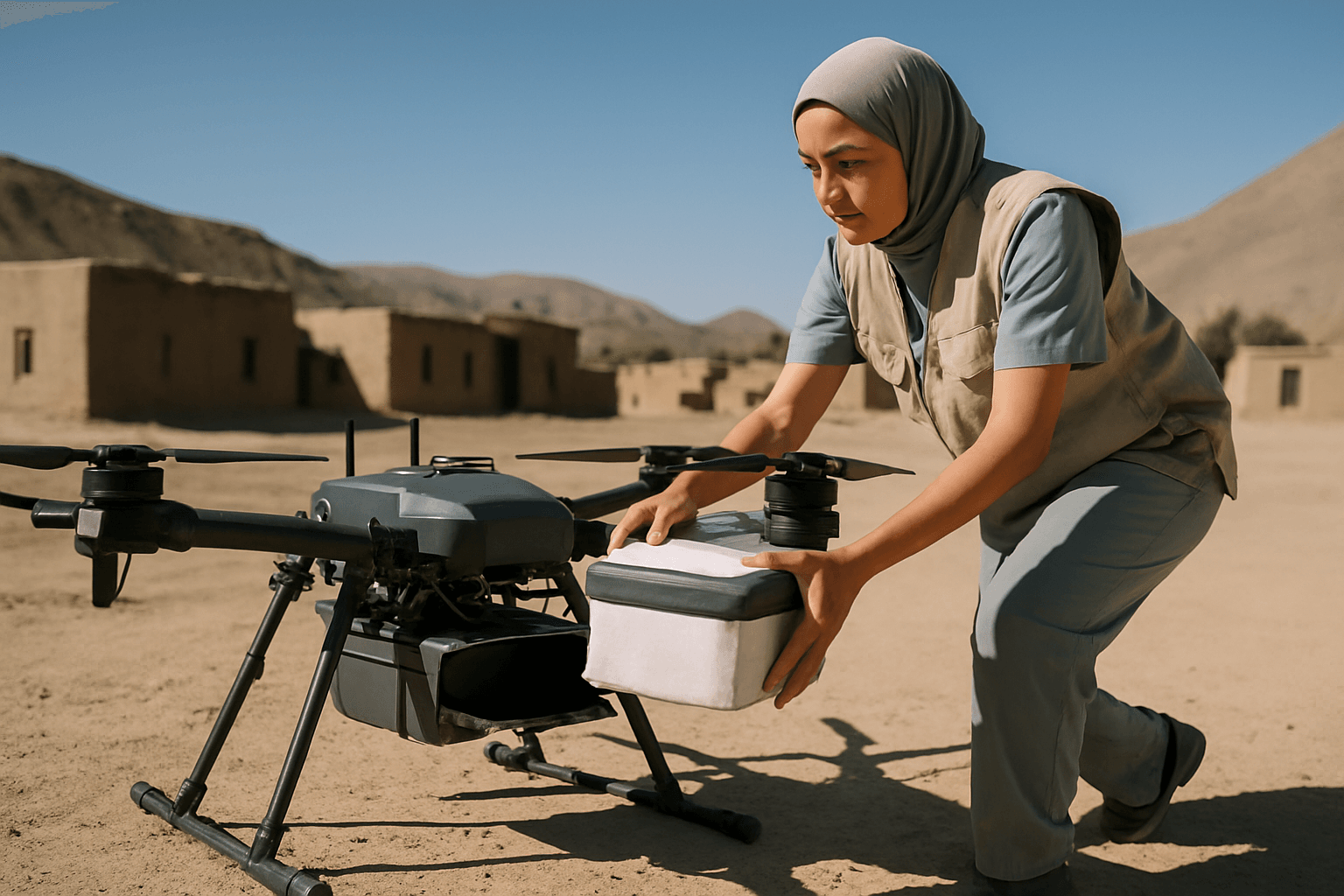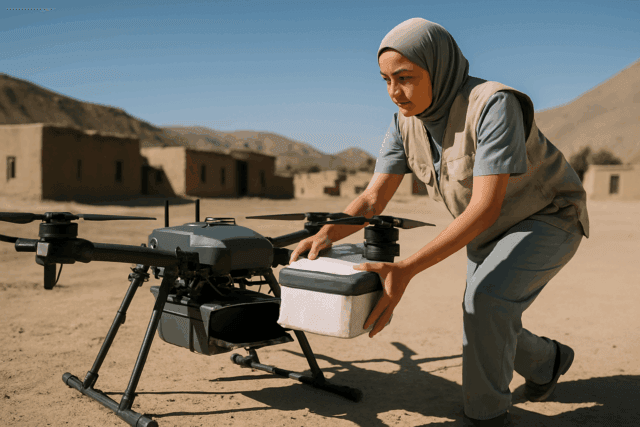Imagine a scenario where life-saving vaccines, critical blood supplies, or essential medications are urgently needed in a village cut off by impassable roads, rugged mountains, or a natural disaster. Traditional transportation methods often fail in these “last-mile” challenges, leading to delayed treatments, compromised patient outcomes, and significant healthcare inequities. However, a silent revolution is taking to the skies: Unmanned Aerial Vehicles (UAVs), commonly known as drones, are rapidly transforming how medical supplies reach the world’s most remote and underserved communities, offering a quicker, more efficient, and often more affordable solution.
The Critical Need for Advanced Delivery Solutions in Remote Regions
Remote and rural areas globally face immense hurdles in accessing consistent and timely medical care. These regions are often characterized by a lack of infrastructure, making them difficult to reach via conventional ground or air transport.
Overcoming Geographical Barriers
Many remote communities are isolated by challenging terrains such as dense forests, mountainous landscapes, or areas without paved roads. In developing countries, specifically, the absence of road connectivity makes last-mile delivery of medical products a persistent problem. Drones bypass these physical impediments, soaring above obstacles that ground vehicles cannot traverse.
The Impact of Delayed Access
Limited access to medical supplies directly translates to lower quality healthcare, delayed treatments, and inadequate care. Without timely access to essential items like vaccines, blood products, or emergency medical equipment, healthcare providers in these regions struggle to deliver proper patient care, potentially leading to increased morbidity and mortality rates. The COVID-19 pandemic further underscored these critical supply chain challenges, highlighting the need for resilient and agile delivery mechanisms.
Key Advantages of Drone-Based Medical Delivery
The integration of drones into medical logistics offers a compelling array of benefits that address many of the long-standing issues faced by remote healthcare systems.
Speed and Efficiency
Unlike ground vehicles, drones are not affected by traffic congestion, roadblocks, or the need to navigate winding, bumpy roads. They can transport medical supplies swiftly and efficiently, often cutting delivery times from several hours to mere minutes. This speed can be a critical factor in medical emergencies, potentially meaning the difference between life and death. For instance, a drone delivery in rural Virginia reduced transport time from 90 minutes by road to just 3 minutes by air.
Enhanced Accessibility and Reach
Drones significantly enhance the accessibility of quality healthcare services by reaching locations that are otherwise inaccessible by traditional transport. This capability ensures that vital medical supplies can reach patients in need regardless of their geographical isolation, thereby improving healthcare equity for underserved communities.
Cost-Effectiveness
Compared to helicopters or other air services, drones are a more affordable option for transporting medical products. They help reduce numerous expenses associated with traditional delivery methods, including labor costs, vehicle maintenance, and fuel. This makes them a viable and sustainable alternative for resource-constrained healthcare systems.
Emergency and Disaster Response
Drones prove invaluable during disaster management or in areas affected by conflict, where critical infrastructure may be damaged. They can rapidly deliver aid, emergency kits, and vital medical supplies to victims or first responders in hard-to-reach locations.
Real-World Applications and Success Stories
The transformative potential of medical drones is not merely theoretical; numerous initiatives worldwide demonstrate their practical impact.
Zipline’s Global Impact
One of the most prominent examples is Zipline, which has established extensive drone delivery networks across Rwanda, Ghana, and Nigeria. Zipline’s autonomous drones have completed over 500,000 deliveries of blood, vaccines, birth control, snake bite serum, and other medical supplies, significantly improving access to critical care in rural areas. Their operations in Ghana, for example, involve multiple distribution centers forming one of the largest medical drone delivery networks globally.
Initiatives in India and Beyond
India has also embraced drone technology for healthcare delivery, particularly in its challenging terrains. Projects like “Medicines from the Sky” in Telangana and the Indian Council of Medical Research’s (ICMR) “I-Drone” initiative in the Northeast region have utilized drones to deliver vaccines and essential medicines, cutting down travel times significantly. Uttarakhand also implemented a drone delivery system for emergency medical supplies in 2019. Beyond India, the UK’s National Health Service made history in 2022 with the world’s first drone-delivered chemotherapy treatment for patients on the Isle of Wight.
Specialized Deliveries: Organs and AEDs
Drones are also being deployed for highly sensitive and time-critical medical transports. In 2021, a drone successfully transported a pair of lungs for transplantation between two hospitals in Toronto, saving the life of a 63-year-old patient. Similarly, trials in Sweden have shown drones delivering Automated External Defibrillators (AEDs) to cardiac arrest scenes faster than traditional ambulances in 64% of cases, potentially increasing survival rates.
The Technology Powering Aerial Medical Logistics
The capabilities of medical delivery drones are underpinned by sophisticated engineering and advanced technological integration.
Advanced Drone Design and Capabilities
Modern medical drones are often Unmanned Aerial Vehicles (UAVs) that incorporate lightweight composite materials and efficient battery technologies, allowing for longer flight ranges and durations. Many utilize vertical take-off and landing (VTOL) capabilities, removing the need for runways and enabling operations in confined spaces.
Autonomous Navigation and Control Systems
These drones rely on Global Positioning Systems (GPS) and other advanced sensors for precise navigation. Autonomous flight and AI integration enable Beyond Visual Line of Sight (BVLOS) operations, which are crucial for long-distance deliveries. Sophisticated software manages drone networks, monitors weather data, and optimizes flight routes to ensure safe and efficient delivery.
Maintaining Integrity: Payload and Temperature Control
A critical aspect of medical drone delivery is maintaining the integrity of sensitive payloads like blood samples, vaccines, or organs. Drones are equipped with specialized compartments that can maintain specific temperature and humidity conditions during transit. While payload capacity can be a limitation (typically 2-4 kg), continuous innovation is improving this aspect, along with flight range and duration.
Navigating the Challenges: Regulations, Safety, and Acceptance
Despite the immense potential, the widespread adoption of medical drone delivery faces several significant challenges.
Regulatory Frameworks and Airspace Integration
National and international aviation authorities have stringent regulations governing drone use, primarily aimed at public safety and preventing collisions. Integrating drone operations, especially BVLOS flights, into existing national airspace systems requires complex regulatory adaptations and collaboration between healthcare stakeholders and aviation authorities. Regulatory gaps remain a persistent issue, needing clearer guidelines for safe and lawful operations.
Privacy, Security, and Public Trust
The use of drones, often equipped with cameras and GPS, raises valid concerns regarding privacy and potential surveillance. Ensuring the security of patient data and medical supplies during drone flights is paramount. Cybersecurity threats like hacking and data breaches are also critical concerns, necessitating robust data encryption and access controls. Gaining public trust and acceptance through transparent communication and proactive measures to mitigate concerns like noise pollution and visual intrusion is essential for widespread adoption.
Overcoming Operational Limitations
Operational challenges include weather dependency (strong winds, rain, snow can affect flight paths), limited battery life impacting flight time, and the need for trained operators. Healthcare facilities must plan for recharging stations and develop contingency plans for adverse weather conditions. Integrating drone transport into existing healthcare systems also requires thoughtful planning for dispatch protocols, coordination with medical teams, and training for healthcare professionals.
The Future Outlook for Drone Medical Deliveries
The future of medical drone delivery is promising. As technology continues to advance, improving battery life, payload capacity, and autonomous capabilities, drones will become even more reliable and versatile. Governments and healthcare providers worldwide are increasingly exploring and investing in drone technology to enhance healthcare equity and efficiency. The UK government, for example, plans to construct a large drone superhighway for delivering medicines, vaccines, and cancer treatments. Further research and collaboration among stakeholders will be vital in overcoming the remaining challenges and realizing the full potential of drones for equitable and efficient healthcare delivery.
Conclusion
Drones are no longer just futuristic gadgets; they are emerging as indispensable tools in modern healthcare logistics, especially for remote areas. By offering unprecedented speed, accessibility, and cost-effectiveness, they are bridging critical gaps in medical supply chains and bringing life-saving care to previously unreachable populations. While regulatory, technical, and societal hurdles remain, the proven benefits and ongoing advancements suggest that drones will play an increasingly vital role in creating a more resilient, equitable, and responsive global healthcare system.





